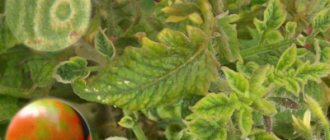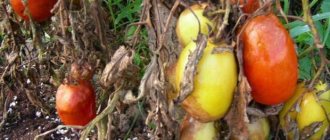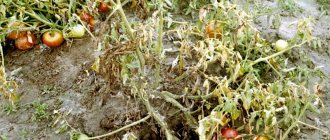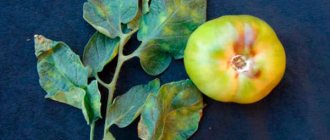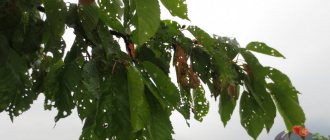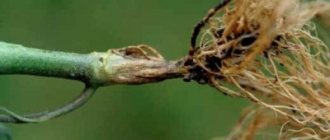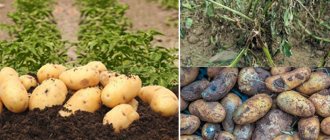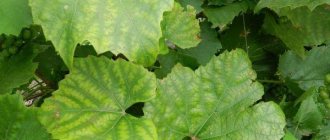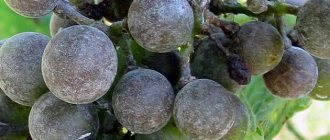Sometimes healthy tomato seedlings suddenly begin to develop incorrectly.
The leaves become deformed and the shape of the bush changes. This may be a signal of infection with a dangerous viral disease - aspermia. Our article will tell you how to prevent the appearance of aspermia in tomatoes and how to cure the plant from this disease if it does occur.
Signs of the disease: description and photo
In the early stages, the disease can be noticed based on the following signs:
- Tomato leaves and stems are deformed.
- Flower brushes are not formed correctly.
- The fruits do not ripen or have an unusual shape.
Due to the disrupted process of cell division, the leaves lose their characteristic tomato shape and become light green even in good sunlight. The main stem stops growing and is replaced by side branches. The growth of the bush slows down.
Reference. The formation of inflorescences occurs rarely. The brushes grow deformed, most of the flowers fall off without setting fruit.
When infected late in the growing season, the fruits grow in an uncharacteristic shape, without seeds. They have no nutritional value due to their hard skin and fibrous pulp. All this can be seen in the photo:
Symptoms of the disease
The disease manifests itself in this way:
- the stem weakens and turns pale;
- the top of the bush grows abnormally;
- axillary shoots grow wildly, but they are all underdeveloped;
- there are few flower racemes or they are deformed, the flowers grow together;
- the upper leaves also become deformed or become smaller;
- the fruits are small, irregular in shape, do not ripen completely and do not produce seeds.
Reasons for appearance
Most often, the virus enters the site along with ornamental plants or wild herbs brought in as mulch or animal feed. These plants may not have characteristic signs of the disease, but are carriers. An extremely rare variant of infection is contaminated soil brought to the site.
The virus is spread throughout the area by insects, for example:
- whitefly;
- aphid;
- leafhopper.
It is also possible to transmit the virus during work with plants. The virus is not transmitted through seeds.
Main diseases of seedlings
As seedlings grow, they can be attacked by viral, bacterial, fungal and some non-infectious diseases. This happens unexpectedly and the rate of infection is very high. Time is the main factor that will give a chance for success. The sooner treatment begins, the higher the likelihood of a full recovery.
Tomato seedlings can become infected for several reasons:
- contaminated soil and seeds (poor quality of seed);
- insect carriers (spread the virus by contacting the plant);
- fluctuations in air masses (high humidity, low temperatures);
- inadequate care (excess and lack of microelements).
Interesting! The aphid's proboscis consists of two pairs of thin channels. One pair is designed to suck out juice from plants, while the second pair allows saliva to flow. If a virus is present, the plant will be infected.
How does the disease develop and why is it dangerous?
The disease develops relatively slowly; at the stage of initial development of seedlings, signs of aspermia can be seen on single specimens. If measures are not taken in time, the virus will spread to all tomatoes.
Depending on the stage of development of tomatoes at the time of infection, the manifestations of the disease vary somewhat. Tomatoes that are diseased at the seedling stage most often do not set fruit; those infected during fruit formation produce a meager harvest of hard, deformed tomatoes. There are no seeds in such fruits.
Bacterial
There are also tomato diseases caused by various pathogenic bacteria:
Bacterial mottling
This bacterial disease is observed on plants in open ground. High humidity and low air temperature are the best conditions for the development of the disease. Bacteria live in the roots of weeds and in the tomato seeds themselves. Bacteria do not live long in the soil itself.
You may also be interested in: Folk remedies for controlling cabbage pests
In the first stages of disease development, small brown oily spots appear on the green above-ground part of the tomato plant. The leaves begin to curl and eventually die completely.
To combat mottling, it is necessary to spray the seedlings (the dosage is indicated on the package) with a solution of Fitolavin-300.
Bacterial cancer
This bacterial disease manifests itself slowly and gradually destroys the entire plant and young fruits. First, the leaves wither and fall off, and brown growths can be observed on the petioles and stem. Plant withering occurs in stages from bottom to top. If you cut the stem, you will see a yellow void in the core.
Often, painful bacteria lie dormant in the plant seeds themselves. And also the cancer pathogen can be in the soil and plant residues.
Crayfish bacteria are resistant to drought and moisture, but cannot tolerate high temperatures. At an air temperature of +45 Celsius, bacteria stop their development, and when the heat rises, they completely die, but the plant also dies. Soil calcination treatment must be carried out before planting.
To treat this disease, you need to treat the seedlings with fungicides containing copper.
On the day of sowing, the seeds must be soaked in a TMTD suspension solution for 2-3 hours.
Bacterial wilt
This viral disease is considered a quarantine disease in mass cultivation of tomatoes. There are no visible signs at the initial stage of wilting development. Signs are visible only when the first fruits are formed. The diseased plant is very frail and underdeveloped, its color is unsaturated. The fruits on such plants are very small and irregular in shape. Tomatoes quickly wilt and dry out completely.
These bacteria live in the soil. Most often, bacteria persist at the site of the old harvest of potatoes, carrots and beets.
The most active spread of the disease begins during the growth and development of fruits, and when watering with low-quality water.
Before planting seedlings in a greenhouse, quarantine treatment must be carried out.
Sick plants are destroyed, as well as everything growing nearby. They need to be removed, and the rest should be watered with a solution of Fitolavin-300 at a concentration of 0.6-1.0%.
You can also spray the seedlings with Fitolovin-300 with the addition of 0.15% liquid glass.
Root cancer
With this disease, bacteria attack the inside of the stem. Small, scattered brown growths form on the stem. In the section of the stem, brown emptiness and rottenness are visible.
Infection occurs through plant debris and contaminated soil.
When the time comes to plant seedlings in open ground, you need to minimize mechanical pressure on the roots of the plants. It is through all the miniature wounds in the roots of tomatoes that cancerous pathogenic bacteria penetrate.
Before planting seedlings, you need to steam the soil and soak its roots in a solution of Fitosporin-M.
Wet rot
This bacterial disease begins its development from the stems. Darkening occurs from the roots along the inner wall of the stem, and then the stem turns brown and softens. After a few days, the above-ground part of the plant rots completely, and only the skin with rotten liquid remains from the fruit.
Plants are infected through insect parasites.
There are no measures to combat rot, you can only exterminate pests. And to prevent development, it is worth calcining the soil before planting seedlings and sowing seeds.
Stem necrosis
This disease affects the most developed plants. Brown spots and small growths in the form of warts appear on tomato stems. Over time, the growths crack, and the tomatoes themselves wither and die. The most favorable temperature for pathogen development is +26-+28 degrees Celsius. When the air temperature rises to +40, the bacteria die. The disease develops due to the sowing of infected seeds or through nearby affected plants.
To avoid infection of plants, it is necessary to carry out all agrotechnical methods of soil treatment before sowing.
There are no chemical means to combat this disease.
Black spot
Plants infected with bacterial spot have an underdeveloped appearance. The plant has a faded color, a thin trunk and deformed leaves. Rust spots form throughout the plant. Only the roots are not affected.
The development of the disease is promoted by plant debris in the soil, as well as by planting infected seeds. Before planting in the ground, seed material must be treated with Fitolovin-300 solution.
Sick plants are recommended to be treated with a 1% solution of Bordeaux mixture.
You may also be interested: Composition of spring whitewash for garden trees
You also need to spray with the fungicide Kartotsid in a ratio of 40 grams of the drug per 10 liters of water. The working solution should be enough for 1 hundred square meters of area.
Treatment
There are no specific means to combat viruses in plants; infected tomatoes cannot be cured. But it is possible to stop the spread of the virus throughout the area.
The following steps must be taken:
- remove and burn affected plants;
- remove and burn mulch from wild plants;
- spray plants with insecticides;
- separate tomatoes from ornamental plants.
Tomatoes are dug up by the roots and stored in a tightly sealed plastic bag before burning to avoid potential insect infestation.
Important! Tomato tops should not be laid out to dry before burning.
It is advisable to use contact insecticides, spraying in the evening, when the bees have finished flying.
Ornamental plants, such as chrysanthemums, must be fenced off with a trellis from diseased tomatoes to make it difficult for insects to fly. In addition to artificial structures, you can use rocker plantings, such as corn.
Fungal diseases of tomatoes
The fungus can affect any part of the plant. This is the most common group of diseases.
Fungi that cause fruit rot are called blight. It comes in different types: brown rot of tomatoes, black, white, gray, root, apical. What is common is the nature of the lesions and preventive measures. Let's look at several types of rot.
White rot
The fungus enters the plant through the soil. The fruits are covered with wet white putrefactive spots.
Most often, damaged areas are affected - ruptures in the skin of the fruit due to excessive growth, mechanical damage, as well as violations of transportation and storage conditions.
Pathogen: fungus of the genus Sclerotinia.
Prevention: soil disinfection during planting, compliance with transportation and storage rules.
Treatment: Treatment of plants with a solution of copper sulfate, urea and zinc diluted in water.
Gray rot
Capable of destroying 50% of the crop. The mycelium of the fungus penetrates the stem and fruits, tissue necrosis develops, they soften and become covered with a gray coating. Fungal spores are very viable and persist in the soil for several years. They can also spread from other crops (for example, cucumbers). The infection spreads by air and water.
Pathogen: fungus of the genus Botrytis cinerea.
Prevention:
- reducing air humidity in the greenhouse;
- removal of infected plants;
- avoid small wounds and cuts through which infection can occur;
- periodic disinfection of greenhouses.
Treatment: chemicals (Bayleton, Euparen), treatment with sodium humate. An effective remedy is to coat the affected areas with fungicidal paste mixed with CMC glue. This procedure must be repeated once every 2 weeks to prevent new spots from appearing.
Tomato root rot
Another name is black leg. It is determined by the appearance of the affected area: the upper part of the root at the root collar turns black and rots. Then the entire plant dies. The fungus spreads in moist soil and persists on plant debris and seeds. Primary infection occurs from old soil and peat. Excess moisture aggravates the disease.
Pathogens: fungi of the genus Rhizoctonia solani.
Prevention: follow the watering regime, disinfect seeds and soil before planting, for example, Pseudobacterin-2 at a rate of 1:100 liters of water, sulfur-containing preparations are also effective
Treatment: remove the affected plant by the roots, treat the ground with 0.25% Ridomil Gold suspension, do not plant tomatoes in this place for 1 year.
The next group of fungi infect the leaves with different spots. Hence their name - spotting. There are black, gray, white, brown, yellow spots on tomato leaves.
Septoria
Another name is white spotting. The fungus infects the leaves, they become covered with light spots, become deformed and dry out. The most favorable conditions for fungus are temperatures from 15 to 27 degrees and air humidity from 77%. The fungus survives on plant debris.
Pathogen: fungus Septoria lycopersici.
Prevention: removing plant debris, maintaining distance when planting, isolating tomatoes from other nightshades.
Treatment: spraying with fungicides.
Cladosporiosis
The second name is brown spot. It affects leaves, on which orange-brown spots appear, which darken and become covered with plaque over time. Like all fungi, the causative agent of tomato disease develops at high humidity and temperature. Disputes persist for up to 10 years. Breeders are constantly improving tomato varieties, breeding species resistant to cladosporiosis.
Pathogens: fungi of the genus Passalora fulva and Cladosporium fulvum.
Prevention: use of varieties that are immune to the disease.
Treatment: spraying with preparations: HOM, Abiga-Pik, Poliram.
Macrosporiasis
Another name is gray spotting of tomato leaves. The etiology of the disease is still the same. Gray-brown spots form on the affected leaves. They increase in size, connect with each other, affecting the leaf tissue. The plant is withering.
Pathogens: fungi of the genus Stemphylium solani.
Prevention: sanitization of soil and seeds before planting, compliance with light conditions.
Treatment: spraying with fungicides.
Alternaria blight
The fungus attacks the leaves, stems and fruits of tomatoes. First, the disease progresses on the leaves, they become covered with large dark brown spots and gradually dry out. The stem also darkens and dies. On fruits, spots form at the stalk; with sufficient moisture, fungal spores develop. The top of the tomato becomes dark, depressed, with a velvety coating. The fungus grows especially quickly at temperatures of 25-30 degrees and high humidity.
Causative agent: mold Alternaria solani Sorauer.
Prevention: treating seeds and soil with antifungal agents (Trichodermin, Fitosporin, etc.), choosing tomato varieties that are resistant to the disease.
Treatment: treatment with copper-containing preparations (Ridomil Gold, Skor) during the growing season, if fruits appear - biological preparations.
You cannot plant tomatoes in a place where potatoes, eggplants, cabbage, and peppers previously grew.
Anthracnose
Tomato anthracnose affects adult plants. The fungus can attack leaves and fruits. In the first case, the leaves wither, the stem becomes bare, the roots become deformed, become weak and thin, and the plant is easily pulled out. On the affected parts you can notice small black seals consisting of fungal mycelium.
If the fungus has infected the fruits, they become covered with depressed flat spots.
Pathogen: fungi of the genus Colletotrichum.
Prevention: seed treatment with Agat-25, during the growing season - with Quadris or Strobi, or based on Bacillus subtilis.
Treatment: During the development of the disease, gardeners recommend spraying the bushes with Poliram at a consumption rate of 2.53 kg/ha.
Verticillium
A fungal disease that attacks old tomato leaves. The production of chlorophyll is disrupted, so the leaves fade and die. The mycelium of the fungus is resistant to temperature changes and persists for a long time in the soil and on plant debris. Later, the roots and stems become infected. The disease spreads from bottom to top up to 1 m in height. There are no drugs that completely kill fungal spores. When choosing tomato varieties, you need to pay attention to resistance to verticillium.
Pathogen: fungi of the genus Verticillium.
Prevention: use of varieties that are immune to the disease.
Treatment: the diseased plant is eliminated, fresh soil is laid out in its place, the soil is improved through crops such as rye, peas, and mustard. They promote the development of microorganisms that destroy harmful fungi.
Powdery mildew
Capable of hitting huge areas. Microscopic spores of the fungus appear as a white coating on tomato leaves. The affected plant becomes deformed. Parts of the leaf become discolored, the plant weakens and dies. Most often it develops in closed ground.
Pathogen: marsupial fungi of the genus Oidium erysiphoides Fr.
Prevention: using varieties that are immune to the disease, taking measures to disinfect greenhouses.
Treatment: spraying with fungicides, sodium humate 0.1 and 0.01% completely destroys the fungus, the drugs “Topaz”, “Quadris”, “Strobi” are also effective.
Ascochyta blight
The second name is stem cancer, due to the fact that the fungus first attacks the stems of plants, and then the disease spreads to the leaves and fruits. The affected areas darken, and depressed, weeping spots appear on them. Cold and wet weather promotes the development of the fungus. Fungal spores persist for a long time in the soil, on plant debris and seeds. Most often it affects greenhouse plants; it is rare in open ground.
Pathogen: fungi of the genus Ascochyta lycopersici.
Prevention: treatment of soil and seeds before planting, increasing the temperature with reducing humidity, ventilating greenhouses.
Treatment: treating stains with a special chalk paste, spraying with growth regulators (Agat-25, Immunocytophyte)
Fusarium wilt
A fairly common disease among nightshades. There are varieties of tomatoes that are resistant to the fusarium fungus; you should pay attention to this when planting. If there is no such mark, then it is worth taking preventive measures to avoid infection.
The disease appears on the leaves and develops from bottom to top. First, chlorotic spots appear, then the leaf becomes deformed and the shoots wither. If you place a twig of an infected plant in a glass of water, you can see white mycellar threads of mushrooms after 1-2 days.
The fungus causes especially great harm to greenhouse crops, affecting the vascular system of plants. Infection occurs from plant debris.
Pathogen: fungi of the genus Fusarium oxysporum.
Prevention: Tilling the soil before planting with Pseudobacterin-2, benzinmidazole, observing crop rotation, carrying out microbiological remediation.
Treatment: Effective drugs to combat fungus are Trichodermin, Benazol, Planriz.
Late blight
A common disease of tomatoes in open ground. Mycelium of the fungus infects the root system and stem through the soil. The leaves are covered with red spots; on the reverse side you can see a light gray coating. Hard brown spots form on the fruits, they rot and fall off. Infection can occur from other nightshades (for example, potatoes).
Pathogen: fungi of the genus Phytophthora infestans.
Prevention: sterilization of the soil before planting, treatment with Pseudobacterin-2, during the growing season - with sodium humate.
Treatment: removal of infected parts of the plant, spraying the plants with a 0.5-1% Baktofit solution at intervals of 8 days or with Agat-25.
Working with soil after this virus
The virus does not live long on its own in the soil, but if there is a carrier, it can survive until the next season. Insect larvae and remnants of the root system of tomatoes can act in this capacity.
After harvesting the tomatoes, it is necessary to remove the bushes by digging out the roots. Removing the top layer will help reduce the number of larvae in the soil and get rid of residual organic matter.
Preventive recommendations
As soon as at least 1 diseased plant appears on the site, it is immediately disposed of by burning. Other methods will not lead to the destruction of the pathogen. The second preventative tip is the use of insecticides to remove adult aphids and larvae:
- “Aktara” - within 30 minutes after application, the pest loses gastronomic interest in the treated crops. Aphid death occurs within 24 hours. The area is treated once every 6 weeks only using chemical protective equipment. The recommended dosage is 4 g for every 10 liters of water.
- “Commander” is a concentrate that needs to be diluted in water and has a wide spectrum of action. One package is enough to process 10 acres. The contents of the package are dissolved in 20 liters of water.
- “Corado” – characterized by an extended period of validity. For every 10 liters of water, take 1 ml of substance. Treatment is carried out only in dry weather.
After the harvest is completed, the gardener is required to weed the beds and dig. All plant residues must be removed. It is advisable to repeat the procedure in spring and autumn. The list of practical recommendations ends with a reminder to observe crop rotation. It is prohibited to grow asters, chrysanthemums and tomatoes in one plot.
Experienced gardeners recommend choosing tomato varieties that are resistant to the viral pathogen. The list of these is as follows:
- "Blitz";
- "Opera";
- "Spartacus";
- "Virtuoso";
- "Bohemia".
Bushiness of the top of a tomato bush is a disease that occurs only in protected soil conditions. Increased humidity levels and consistently warm weather are the best conditions for the accelerated development of the virus. The aphid acts as a carrier of the virus, so it and its larvae must be constantly fought. The peak activity of the pathogen is January and February. During the specified time period, it is necessary to carry out regular inspection of the plantings.
Prevention measures
- Do not grow ornamental and vegetable crops nearby.
- Treat tools, hands, gloves after working with various crops.
- Treat tomato seedlings against insects every two weeks.
- Do not use grass as mulch.
- Remove weeds in a timely manner.
- Destroy seedlings with abnormal development.
- Use nitrogen fertilizers carefully.
- It is not advisable to plant ornamental plants, especially chrysanthemums, near beds with tomatoes. This creates a high risk of tomatoes becoming infected with a viral infection.
- When growing tomatoes and flowers in the same greenhouse, special attention is paid to insect control.
- Working tools are disinfected after each processed crop.
- Various contact and systemic insecticides are used for treatment. If there is an apiary near the site, it is undesirable to use systemic insecticides with a long-term effect of the active substance.
- Many wild plants are carriers of viruses; it is better to use inorganic materials as mulching material.
- Weeds not only deprive tomatoes of nutrients, but are also a breeding ground for dangerous insects.
- When growing seedlings, it is necessary to discard plants that differ from others. Remove specimens that are lighter than the main mass, with spotted or uncharacteristically shaped leaves.
- High doses of nitrogen fertilizers weaken the plant, putting it at risk of infection with various diseases.
Tomato aspermia is an incurable disease, but preventive measures taken in time will help save the bulk of the crop.
How to deal with aspermia
There are several ways to fight this disease:
- Remove reserve plants.
Considering that the virus is reserved on various plants, for prevention it is not recommended to grow flowers, ornamental plants, and green crops in a greenhouse that are affected by aphids. It is unacceptable to place indoor plants in the greenhouse.
- Poison insect carriers.
Foci of the disease can quickly spread throughout the entire area by insects living in the greenhouse: aphids, callflies, click beetles, cutworms. Insecticidal treatments against insects should be carried out not only in the greenhouse, but also around it. You can use the following drugs according to the manufacturer’s instructions: “Iskra”, “Commander”, “Biotlin”.
- Destruction of weeds.
Timely removal of weeds not only prevents the virus from pooling on their surface, but also improves the microclimate in the greenhouse and improves ventilation. A clean, dry greenhouse creates unfavorable living conditions for insects.
It is unacceptable to grow chrysanthemums, phlox, cannas, lettuce, and tobacco next to greenhouses and tomato beds, as they are the most active carriers of the aspermia virus.
Where do pests and diseases come from on seedlings?
Diseases of tomato seedlings and their treatment are necessary knowledge for a gardener. Even at home, young sprouts can be in trouble. Seedlings become sick if:
- it is not properly cared for - following the recommendations contributes to the development of the seedlings’ immunity, which will protect them from pests and diseases;
- the substrate was made independently - saving on soil can lead to planting in soil contaminated with insects or pathogenic microflora;
- There are other indoor plants in the room with tomatoes - from them, young seedlings can pick up fungi or infections, mites.
Improper care can cause diseases and pests to appear on tomato seedlings.
If it is not possible to purchase prepared soil, then the garden substrate must be disinfected. It is calcined, spilled with special compounds with special care to protect future seedlings.
Fighting many seedling lesions may be futile, but prevention can protect seedlings.
Rotten
Diseases of tomato seedlings are often introduced into plants from contaminated soil, but they can also be brought in with dirty hands. Many fully manifest themselves only after planting in a garden or greenhouse.
Root rot
On already picked seedlings, other diseases of tomato seedlings may also appear, such as root rot, which is a fungal infection. It develops more slowly than soft rot. First, the leaves turn pale and yellow, then a brown coating appears at the bottom of the stem, and a constriction occurs.
Root rot in tomato seedlings
Affected seedlings will have to be removed, and the soil and neighboring plants will have to be treated with a fungicide. It is necessary to reduce the number of waterings and sprinkle the surface of the soil with ash. It is worth replacing the top substrate of nearby sprouts.
Late blight, late blight rot
Late blight is a frost-resistant fungus that can exist in the ground for several years. It harms various vegetable crops, not only tomatoes, but also potatoes, eggplants, and affects seedlings if the substrate was prepared from soil taken from the garden.
At first, the surface of the leaf may turn white, then brown spots appear. The sprout bends and withers. Fruits affected by this disease are unsuitable for eating.
Persistent fungus is destroyed by spraying with a solution of copper sulfate or treatment with specialized chemicals. Trichopolum, which can be purchased at a pharmacy, helps. You need to dissolve one tablet per liter of water.
Fusarium root rot
Fusarium wilt is characterized by a slow progression, and the disease fully manifests itself on adult bushes or on seedlings prepared for transplanting into open ground. The pathogen is usually found in the soil. Symptoms of the disease resemble a lack of water, and the seedlings gradually dry out.
The soil must be treated with a systemic fungicide, diseased shoots must be removed, and the hole must be sprinkled with dry peat.
